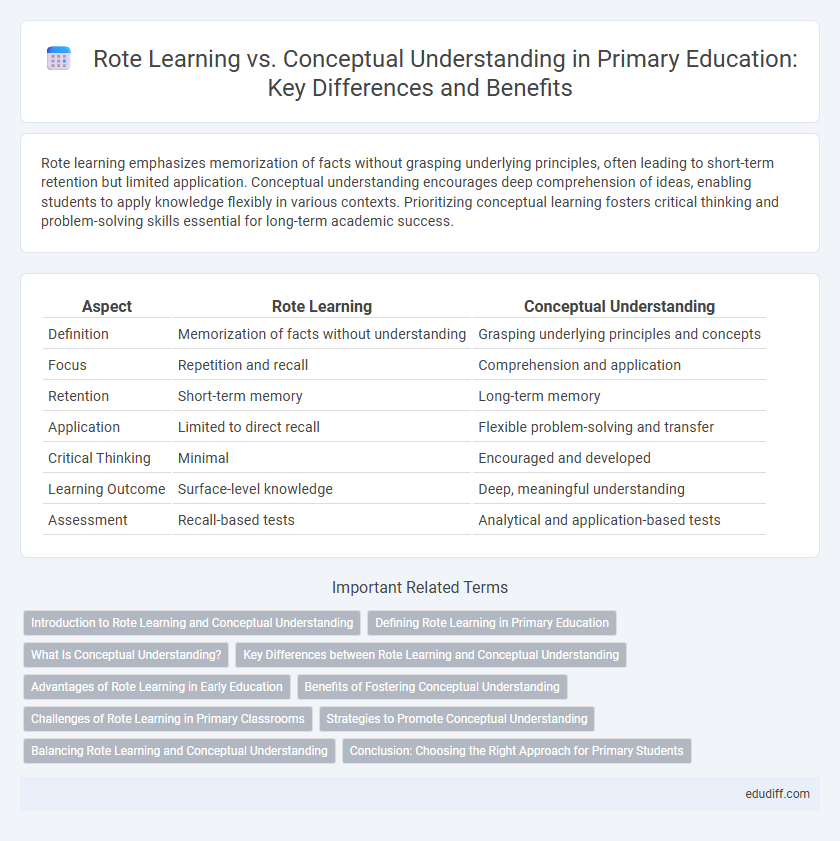Rote learning emphasizes memorization of facts without grasping underlying principles, often leading to short-term retention but limited application. Conceptual understanding encourages deep comprehension of ideas, enabling students to apply knowledge flexibly in various contexts. Prioritizing conceptual learning fosters critical thinking and problem-solving skills essential for long-term academic success.
Table of Comparison
| Aspect | Rote Learning | Conceptual Understanding |
|---|---|---|
| Definition | Memorization of facts without understanding | Grasping underlying principles and concepts |
| Focus | Repetition and recall | Comprehension and application |
| Retention | Short-term memory | Long-term memory |
| Application | Limited to direct recall | Flexible problem-solving and transfer |
| Critical Thinking | Minimal | Encouraged and developed |
| Learning Outcome | Surface-level knowledge | Deep, meaningful understanding |
| Assessment | Recall-based tests | Analytical and application-based tests |
Introduction to Rote Learning and Conceptual Understanding
Rote learning involves memorizing information through repetition without grasping the underlying meaning, often leading to short-term retention but limited application. Conceptual understanding emphasizes comprehending principles and relationships within a subject, enabling deeper insight and flexible problem-solving. Balancing rote learning with conceptual understanding enhances educational outcomes by combining memorization with critical thinking skills.
Defining Rote Learning in Primary Education
Rote learning in primary education involves memorizing facts, formulas, or vocabulary without necessarily understanding the underlying concepts. This method emphasizes repetition and recall to build foundational knowledge quickly. While effective for retaining basic information, rote learning often lacks the depth needed for higher-order thinking skills.
What Is Conceptual Understanding?
Conceptual understanding involves grasping the underlying principles and relationships that connect various facts or ideas, enabling learners to apply knowledge flexibly in different contexts. Unlike rote learning, which emphasizes memorization of isolated information, conceptual understanding fosters critical thinking and problem-solving skills by encouraging deeper cognitive processing. This approach enhances long-term retention and promotes meaningful learning experiences across academic disciplines.
Key Differences between Rote Learning and Conceptual Understanding
Rote learning involves memorizing facts and information without grasping the underlying principles, leading to short-term recall rather than deep comprehension. Conceptual understanding emphasizes grasping the meaning and interconnections of ideas, fostering critical thinking and long-term retention. Key differences include rote learning's focus on repetition and surface knowledge, whereas conceptual understanding promotes cognitive engagement and application of concepts.
Advantages of Rote Learning in Early Education
Rote learning in early education enhances memory retention by enabling students to quickly recall basic facts, such as multiplication tables and alphabet sequences, which forms a foundation for advanced learning. This method supports the development of cognitive skills by promoting repetitive practice that strengthens neural pathways. Early mastery of fundamental knowledge through rote learning facilitates confidence and academic readiness for more complex subjects.
Benefits of Fostering Conceptual Understanding
Fostering conceptual understanding in primary education promotes critical thinking and problem-solving skills by enabling students to connect ideas and apply knowledge across different contexts. It encourages deeper retention of material compared to rote learning, which often leads to short-term memorization without comprehension. Conceptual understanding supports lifelong learning and adaptability, essential for tackling complex real-world challenges.
Challenges of Rote Learning in Primary Classrooms
Rote learning in primary classrooms often leads to surface-level memorization without fostering deep comprehension, which limits students' ability to apply knowledge in different contexts. This method can hinder critical thinking development and reduce student engagement by making lessons monotonous and repetitious. Furthermore, reliance on rote memorization may cause difficulties in long-term retention and concept transfer essential for advanced learning stages.
Strategies to Promote Conceptual Understanding
Strategies to promote conceptual understanding include using active learning techniques such as problem-solving, discussions, and real-world applications that connect new information to prior knowledge. Incorporating visual aids like mind maps and diagrams helps students grasp abstract concepts more effectively. Encouraging metacognitive practices, such as self-explanation and reflective questioning, deepens comprehension beyond rote memorization.
Balancing Rote Learning and Conceptual Understanding
Balancing rote learning and conceptual understanding enhances knowledge retention and application by integrating memorization with critical thinking. Effective education strategies emphasize foundational facts alongside deep comprehension, allowing learners to connect ideas and solve complex problems. This combined approach fosters both immediate recall and long-term intellectual growth, crucial for academic success and practical innovation.
Conclusion: Choosing the Right Approach for Primary Students
Primary students benefit most from a balanced approach combining rote learning's memorization techniques with conceptual understanding's focus on critical thinking and problem-solving skills. Integrating both methods supports foundational knowledge retention while fostering deeper comprehension and application of concepts in real-life scenarios. Educators should tailor strategies to individual learning styles, maximizing engagement and long-term academic success in early education.
Rote Learning vs Conceptual Understanding Infographic

 edudiff.com
edudiff.com